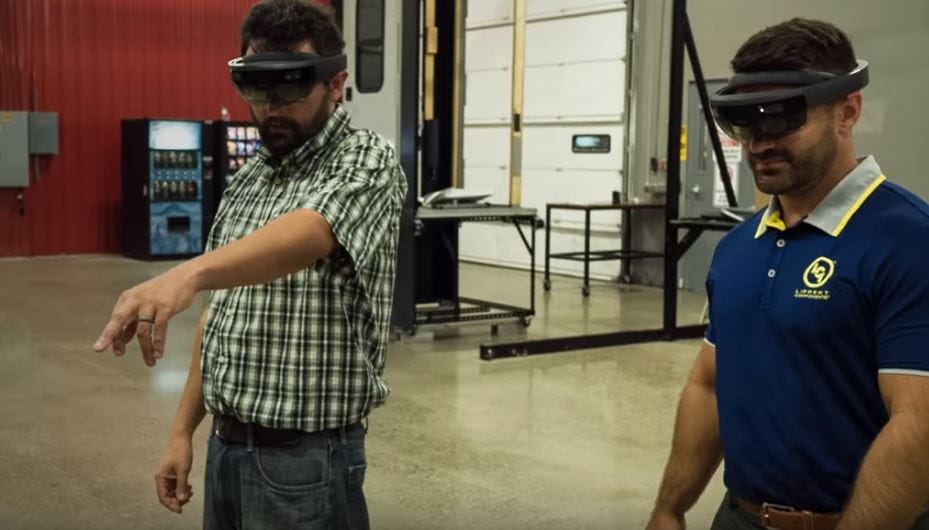Lippert: Augmented Reality Tool the First of Many
 The technology uses a Microsoft HoloLens to "see" the components before prototypes are manufactured.
The technology uses a Microsoft HoloLens to "see" the components before prototypes are manufactured.
Subscriber Benefit
As a subscriber you can listen to articles at work, in the car, or while you work out. Subscribe NowPrototyping will never be the same at Elkhart-based Lippert Components Inc. (LCI). The RV component manufacturer says it’s swapping clunky back-and-forths among the client, engineering and production for a streamlined product development method: augmented reality. LCI Director of Digital Innovations Michael Rupchock says the company is leading the way as the manufacturing industry explores a new technique to envision a product before producing it.
For those unfamiliar with augmented reality, Rupchock says the popular Pokémon GO app is a helpful example; using a smartphone’s camera, the game puts 3D characters in the world around you. But rather than catching critters, users of LCI’s new technology can see a 3D visualization of a product’s CAD (computer-aided design) model in their location.
Called LCI Workbench, the technology uses a Microsoft HoloLens, which looks like virtual reality goggles. The wearer can visualize a product to exact size specifications in whatever environment they’re standing in. For example, if LCI is making a piece of furniture for an RV manufacturer, the OEM—perhaps many states away—can use the technology to visualize exactly how it would look and fit while standing in an RV.
“I wouldn’t say [LCI Workbench] is better than making a physical prototype, I would say it’s quicker,” says Rupchock. “For any discerning customer, they’re still going to want to see that prototype, and we’re not going to deny them of that. This is going to be a quicker layer before that prototype is in their hand. They can visualize a new component on their RV, and help us make better prototypes and make decisions quicker.”
Using existing hardware—such as the Microsoft HoloLens—as the framework, LCI developed the software and applications to customize augmented reality for its purposes. If clients don’t have a Microsoft HoloLens, they can use an iPad or iPhone to visualize the product in their surroundings. LCI sends a digital file, and LCI Workbench software displays the product in the end-users’ surroundings.
Rupchock says LCI Workbench allows the company to move more nimbly, cut time and cost in many ways, and “you don’t have to drag physical prototypes with you.” The company believes the tool is eliminating the expensive and time-consuming trial and error phase of conventional product development. Five LCI clients are currently using the technology, and the company expects that number to grow.
Rupchock notes the technology is gaining traction in the manufacturing industry; he says others are using it to envision machines on production floors or what products might look like on a vehicle. But he believes LCI is on the leading edge of deploying the power of augmented reality in the RV sector.
“The barrier to entry isn’t that difficult, so I wouldn’t be surprised to see a lot of our [partners] playing with [augmented reality] themselves,” says Rupchock. “They can reach out to us, and we’ll help as much as we can. In the RV industry, we’re all in this together.”
Rupchock believes any company with moderate mobile app development capabilities can unleash augmented reality tools, if they’re able to dedicate the time and focus. He says it felt like “a bit of a gamble” to develop the new technology, but that LCI’s partners are welcoming it with excitement.
LCI says it has other augmented reality tools in the pipeline that could be even more impactful, but can’t share details about what it’s developing. The manufacturer is also looking to move beyond the business world and explore how to bring augmented reality to customers.
“There’s a great appetite for innovation in the industry. The amount of project ideas and…number of people who want to be a part of it is staggering,” says Rupchock. “It’s validation that this technology is going to be around for a while, and that LCI is going to be leading the charge in its application. We’re scratching the surface; I’m excited about the almost unlimited possibilities for the future.”
Rupchock says other manufacturers considering developing augmented reality applications shouldn’t be intimidated.
As augmented reality technology becomes less expensive and more common, Rupchock believes it will soon be a method to connect with consumers.
